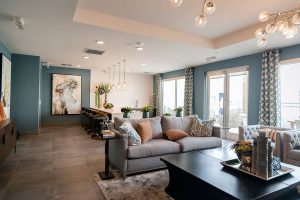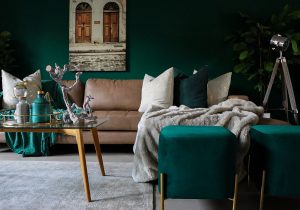Lifescape
By Janet Armstrong,
Certified Interior Designer, CAPS
Paint is the ultimate magician
 We know that paint is one of the easiest and most economical ways to update and refresh your spaces. But paint is also an easy and effective way to address design challenges you may have in your spaces. Darker and/or warmer colours make a wall appear to come forward while lighter colours make things recede. On that basis, paint is a magician for making a low ceiling appear higher, a high ceiling feel lower, for making a narrow room feel wider, and a long room feel shorter. Following are some ideas and suggestions using colour as well as colour placement to address your space design challenges and camouflaging those design ‘challenges’ you may have in your homes.
We know that paint is one of the easiest and most economical ways to update and refresh your spaces. But paint is also an easy and effective way to address design challenges you may have in your spaces. Darker and/or warmer colours make a wall appear to come forward while lighter colours make things recede. On that basis, paint is a magician for making a low ceiling appear higher, a high ceiling feel lower, for making a narrow room feel wider, and a long room feel shorter. Following are some ideas and suggestions using colour as well as colour placement to address your space design challenges and camouflaging those design ‘challenges’ you may have in your homes.
Low ceilings
If the ceilings in your space are low, create a more spacious, open feel by painting the ceiling a lighter colour than the walls. I prefer a bright white ceiling to lift a room and make the entire space feel more expansive than it is, but it could be a lighter tint of the wall colour. Another tip for low ceilings—paint them in a semi-gloss or glossy finish to reflect light and make them visually higher.
 High ceilings
High ceilings
Many people wish for high ceilings, but these can prove to be as much of a design challenge as low ceilings. High ceilings can make a room feel austere and cold. If you want the space to feel warmer and more comfortable, paint the ceiling in a darker colour than the walls. Before you have visions of a dark navy or black ceiling, the colour only has to be a shade or two darker to make it appear lower, not a deep, saturated colour.
Narrow room
A narrow room is a challenge from a layout perspective but also difficult to make it a comfortable and cohesive space. Paint the side walls a lighter colour and the end wall a darker shade to pull it forward. This will make the room feel shorter and wider. This is also an opportunity to add a splash of colour that can be repeated in accessories and textiles.
Short room
If your room is short, painting the far wall and ceiling the same colour will give the illusion of a longer, more spacious room. The eye will also
be drawn to the far wall and perceive more depth in the space. Adding white wainscotting along the side and across the end walls will enhance the illusion of a deeper space.
 Small space
Small space
The ‘rule of thumb’ has been to paint small spaces lighter hues to make them look and feel bigger. However, rich hues add depth to a small space making it actually appear larger. The secret is to ensure you paint all walls the same colour and have a monochromatic colour scheme adding in decor accessories and linens in the same colour family as the walls. If you aren’t ready to commit to a darker hue, a light colour on the walls also makes a small space brighter and feel more spacious. To enhance this, keep the number of decor accessories and patterns in
the space minimal.
Large space
While many of us yearn for larger spaces, they can be just as challenging as a small space to decorate. The upside of a large space is that any colour can be used. However, ensure the shade of colour you select has a warm undertone to make the room feel comfortable and cozy. Of course, adding in heavily textured textiles such as velvet, faux fur, or brocade will add additional depth and richness to the space.
If you have an awkward space that is challenging you, remember the colour and application of paint can create the illusion of a balanced, proportionate room. Using these tips, you can create‘ hide’ the awkward design feature and create a comfortable, harmonious room you won’t want to leave. n
Janet Armstrong (simplyswankdecor.ca) is a graduate of the Interior Design Institute of Canada, CAPS (Certified Aging in Place Specialist) and Chair of the Decorators and Designers Association of Canada (DDA Canada).






